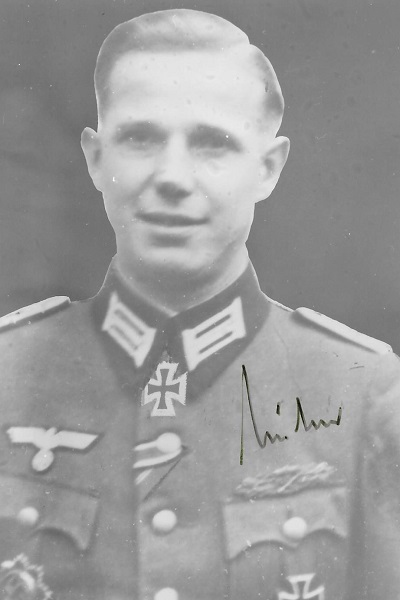Nuhn, Heinrich
- Date of birth:
- January 2nd, 1915 (Niederaula/Hesse-Nassau, Germany)
- Date of death:
- June 7th, 1998 (Munich/Bavaria, Germany)
- Nationality:
- German (1933-1945, Third Reich)
Biography
Do you have more information about this person? Inform us!
- Period:
- Second World War (1939-1945)
- Rank:
- Hauptmann (Captain)
- Unit:
- Kommandeur, Panzer-Pionier-Bataillon 124, Führer-Grenadier-Division, Heer
- Awarded on:
- May 9th, 1945
“Hauptmann Nuhn has proven himself to be a brave and capable officer during his service with the Division. His own fearless devotion to duty has motivated his Bataillon to repeatedly achieve exceptional feats of arms even in the most trying of circumstances.
He has particularly distinguished himself during the defensive battles of the Division in the area 20 km NE of Vienna. Here it was his brave and prudent leadership that was primarily responsible for the enemy’s inability to break through the 30 km wide front with their strong forces and capture the Danube bridges. This was in spite of the fact that his Bataillon bore the brunt of the fighting for 3 days.
Especially notable was the bold and skillful leadership of his Bataillon on the 01.04.1945. On this day his Division was in the process of marching out of Vienna in order to engage the enemy forces that were reportedly advancing from the east and northeast. Hauptmann Nuhn’s Bataillon had the mission of setting up a defense along the Russbach stream on both sides of Deutsch-Wagram. However the enemy preempted the Bataillon, and after quickly brushing aside the Alarm units positioned there they pressed their attack towards the southwest.
Hauptmann Nuhn was only alerted to this enemy activity through their continued advance, and he proceeded to first seal off the penetration with his own forward elements. Then, in order to eliminate the bridgehead, he initiated a counterattack along the railroad towards the east. Leading at the head of his men, he succeeded in eliminating the bridgehead itself in an energetic attack. Sensing the enemy’s momentary weakness, he proceeded to strike into the village itself and throw back the enemy while inflicting heavy losses in men and materiel. The enemy were pushed back to the village centre, and it was only after the arrival of 8 enemy tanks (of which 2 were destroyed by Panzerfausts) that the attack came to a halt.
Hauptmann Nuhn’s bravery and energy were invaluable for successful execution of this attack, and the victory here secured the following results:
1.) The interception of the enemy’s thrust towards the Vienna bridges, a move which could have had potentially disastrous consequences for the entire Vienna operation.
2.) The enabling of the Division’s own uninterrupted assembly, which itself laid the groundwork for the successful subsequent defensive fighting.”
His nomination by the troop was received by the Heerespersonalamt (HPA—Army Staff Office) on 28-4-1945 as teleprinter message. The HPA did not create a nomination request nor is Nuhn listed in the book of "Verliehene Ritterkreuze" (Awarded Knight Crosses). No further remarks or comments have been noted. The registry of rejected or deferred nominations contains his file card. According to the Association of Knight's Cross Recipients (OdR) the presentation was made in accordance with the Dönitz-decree. This is illegal according to the Deutsche Dienststelle (WASt) and lacks legal justification. The presentation date was assigned by Walther-Peer Fellgiebel.
- Period:
- Second World War (1939-1945)
- Awarded on:
- May 14th, 1944
- Period:
- Second World War (1939-1945)
- Awarded on:
- February 16th, 1944
- Period:
- Second World War (1939-1945)
- Rank:
- Oberleutnant (1st Lieutenant)
- Unit:
- 3. Kompanie, Pionier-Bataillon 389, 389. Infanterie-Division, Heer
- Awarded on:
- January 13th, 1944
- Period:
- Second World War (1939-1945)
- Awarded on:
- August 19th, 1942
- Period:
- Second World War (1939-1945)
- Awarded on:
- January 6th, 1942
- Period:
- Second World War (1939-1945)
- Awarded on:
- December 2nd, 1941
- Period:
- Second World War (1939-1945)
- Awarded on:
- August 24th, 1941
Sources
- Photo 1: Known to STIWOT
- - FELLGIEBEL, W.P., Elite of theThird Reich, Helion & Company Limited, Solihull, 2003.
- PATZWALL, K. & SCHERZER, V., Das Deutsche Kreuz 1941-1945, Verlag Klaus D. Patzwall, Norderstedt, 2001.
- TEGETHOFF, RALPH, Die Ritterkreuzträger des Panzerkorps Großdeutschland und seiner Schwesterverbände, DS- Vlg. o.J., Riesa, 1998.










